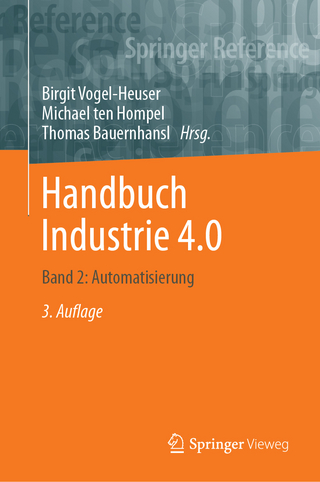
Discrete-continuum Coupling Method to Simulate Highly Dynamic Multi-scale Problems
ISTE Ltd and John Wiley & Sons Inc (Verlag)
978-1-84821-771-3 (ISBN)
This book, the second in the Discrete Element Model and Simulation of Continuous Materials Behavior set of books, shows how to choose the adequate coupling parameters to avoid spurious wave reflection and to allow the passage of all the dynamic information both from the fine to the coarse model and vice versa. The authors demonstrate the coupling method to simulate a highly nonlinear dynamical problem: the laser shock processing of silica glass.
Mohamed Jebahi is a post-doctoral researcher at the Institute of Mechanics and Engineering of Bordeaux, France, and Laval University, Quebec, Canada. Frédéric Dau is Assistant Professor at Ecole Nationale Supérieure d’Arts et Métiers, ParisTech, France. Jean-Luc Charlesis Assistant Professor at Ecole Nationale Supérieure d&'Arts et Métiers, ParisTech, France. Ivan Iordanoff is Director of Research and Innovation at Ecole Nationale Supérieure d'Arts et Métiers, ParisTech, France.
List of Figures ix
List of Tables xv
Preface xvii
Introduction xix
Part 1. Discrete-Continuum Coupling Method to Model Highly Dynamic Multi-Scale Problems 1
Chapter 1. State of the Art: Concurrent Discrete-continuum Coupling 3
1.1. Introduction 3
1.2. Coupling challenges 4
1.2.1. Dissimilar variables due to different mechanical bases 4
1.2.2. Wave reflections due to different analysis scales 4
1.3. Coupling techniques 10
1.3.1. Edge-to-edge coupling methods 11
1.3.2. Bridging domain coupling methods 15
1.3.3. Bridging-scale coupling methods 19
1.3.4. Other coupling techniques 23
1.4. Conclusion 25
Chapter 2. Choice of the Continuum Method to be Coupled with the Discrete Element Method 27
2.1. Introduction 27
2.2. Classification of the continuum methods 28
2.2.1. Grid-based methods 28
2.2.2. Meshless methods 33
2.3. Choice of continuum method 38
2.4. The constrained natural element method 41
2.4.1. Natural neighbor interpolation 41
2.4.2. Visibility criterion 48
2.4.3. Constrained natural neighbor interpolation 48
2.4.4. Numerical integration 49
2.5. Conclusion 51
Chapter 3. Development of Discrete-Continuum Coupling Method Between DEM and CNEM 53
3.1. Introduction 53
3.2. Discrete-continuum coupling method: DEM-CNEM 54
3.2.1. DEM-CNEM coupling formulation 54
3.2.2. Discretization and spatial integration 59
3.2.3. Time integration 62
3.2.4. Algorithmic 63
3.2.5. Implementation 66
3.3. Parametric study of the coupling parameters 67
3.3.1. Influence of the junction parameter l 71
3.3.2. Influence of the weight function α 73
3.3.3. Influence of the approximated mediator spaceM˜ 79
3.3.4. Influence of the width of the bridging zone LB 79
3.3.5. Dependence between LB andM˜ 81
3.4. Choice of the coupling parameters in practice 83
3.5. Validation 84
3.6. Conclusion 85
Part 2. Application: Simulation of Laser Shock Processing of Silica Glass 89
Chapter 4. Some Fundamental Concepts in Laser Shock Processing 91
4.1. Introduction 91
4.2. Theory of laser–matter interaction: high pressure generation 92
4.2.1. Generation of shock wave by laser ablation 93
4.2.2. Shock wave propagation in materials 96
4.2.3. Laser-induced damage in materials 106
4.3. Mechanical response of silica glass under high pressure 109
4.3.1. Silica glass response under quasi-static hydrostatic compression 109
4.3.2. Silica glass response under shock compression 114
4.3.3. Summary of the silica glass response under high pressure 118
4.4. Conclusion 119
Chapter 5. Modeling of the Silica Glass Mechanical Behavior 121
5.1. Introduction 121
5.2. Mechanical behavior modeling 122
5.2.1. Modeling assumption 123
5.2.2. Cohesive beam model 124
5.2.3. Quasi-static calibration and validation 127
5.2.4. Dynamic calibration and validation 139
5.3. Brittle fracture modeling 147
5.4. Conclusion 149
Chapter 6. Simulation of Laser Shock Processing of Silica Glass 151
6.1. Introduction 151
6.2. LSP test 153
6.3. LSP model 155
6.4. Results 159
6.5. Conclusion 163
Conclusion 165
Bibliography 171
Index 185
| Verlagsort | London |
|---|---|
| Sprache | englisch |
| Maße | 165 x 244 mm |
| Gewicht | 476 g |
| Themenwelt | Informatik ► Weitere Themen ► CAD-Programme |
| Technik ► Maschinenbau | |
| ISBN-10 | 1-84821-771-4 / 1848217714 |
| ISBN-13 | 978-1-84821-771-3 / 9781848217713 |
| Zustand | Neuware |
| Informationen gemäß Produktsicherheitsverordnung (GPSR) | |
| Haben Sie eine Frage zum Produkt? |
aus dem Bereich


